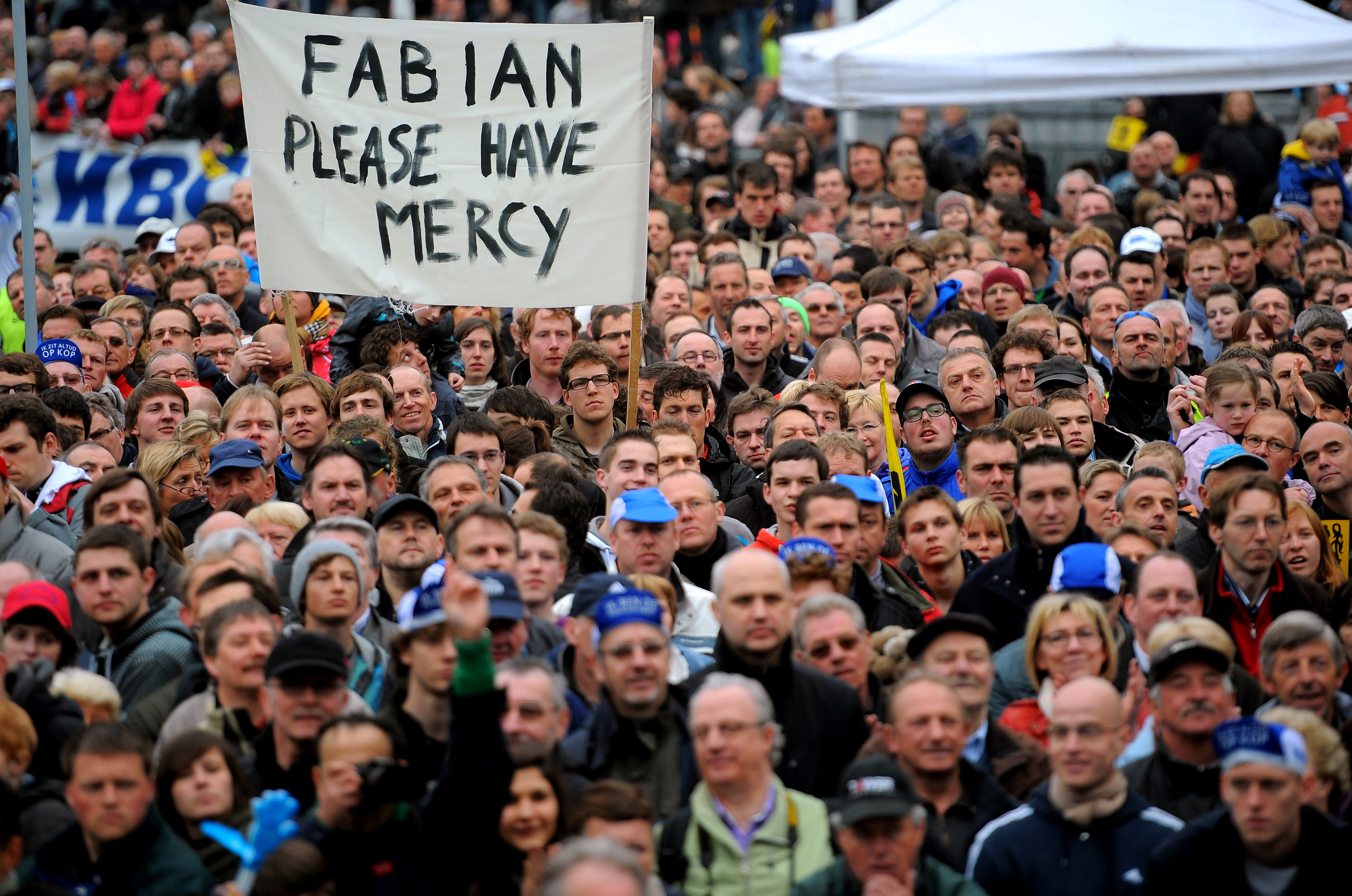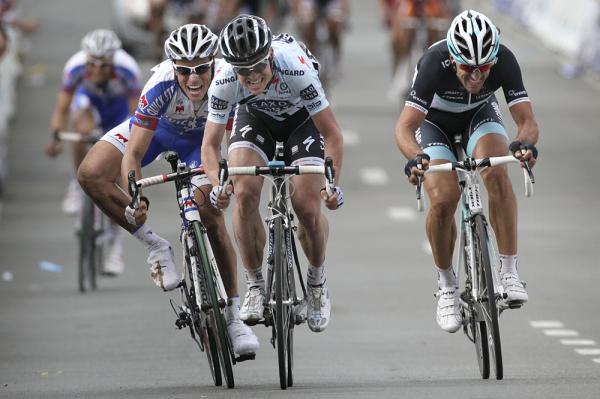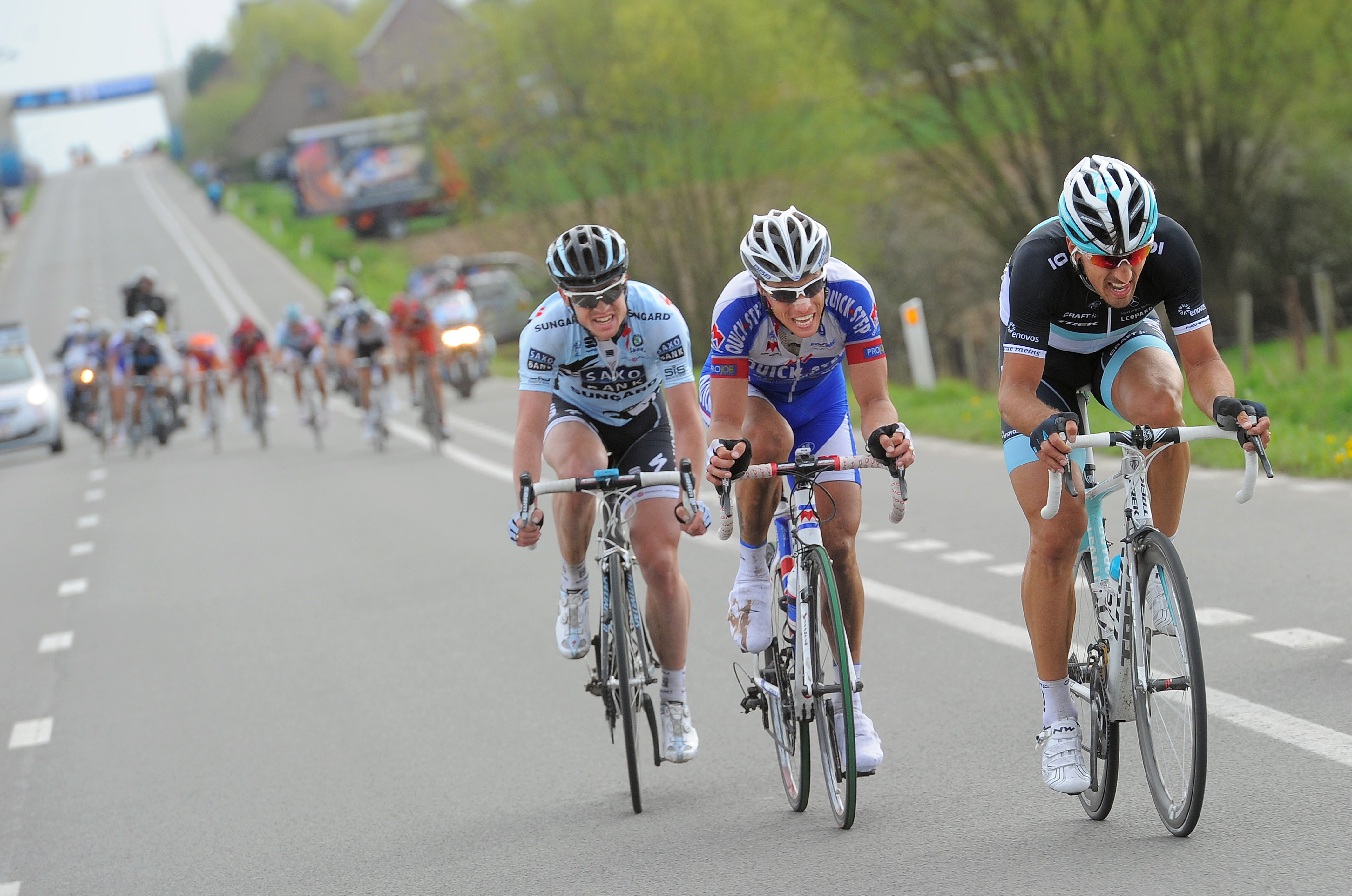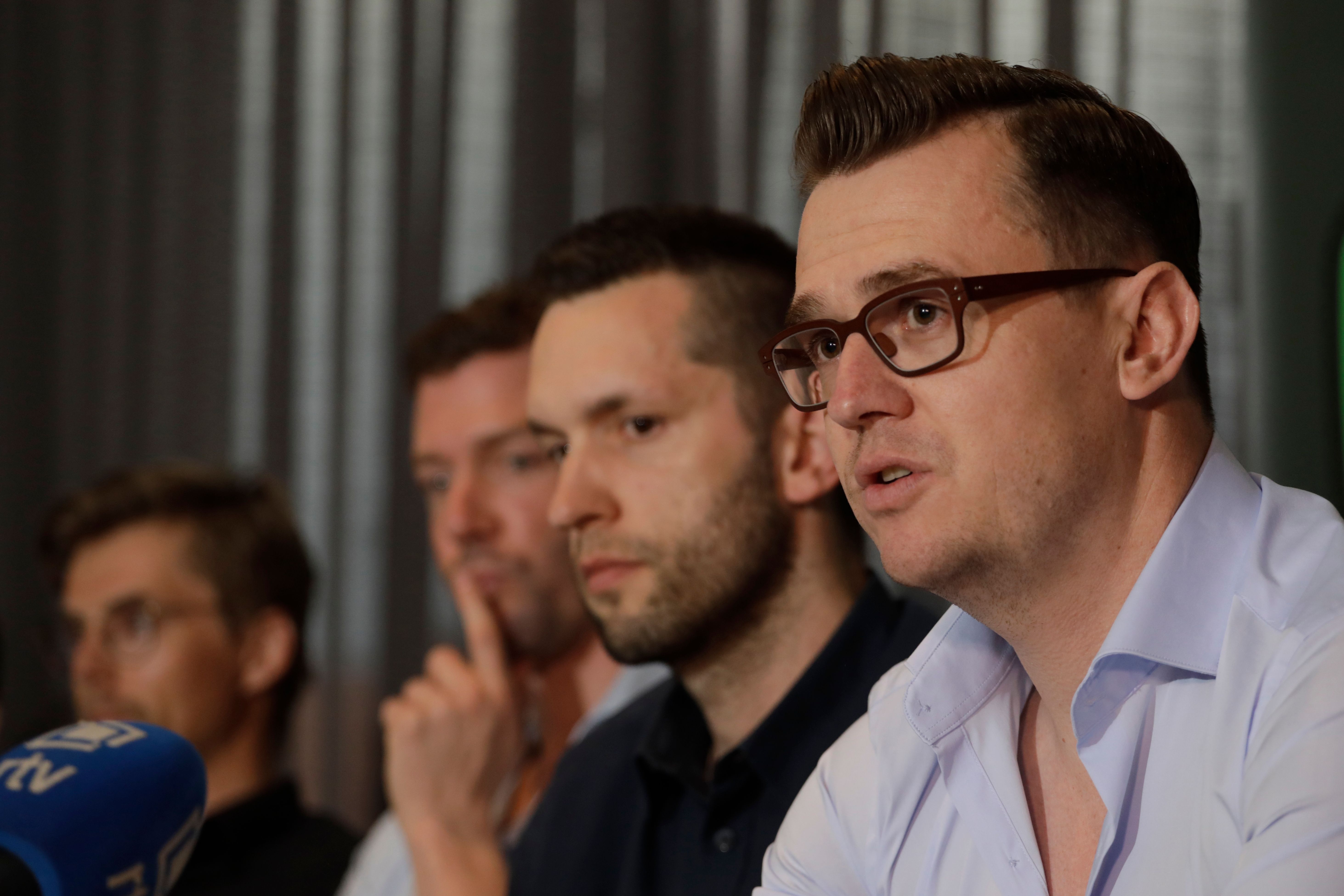Hitting the wall: Nick Nuyens on beating Cancellara at the 2011 Tour of Flanders
'I already knew I would never have that emotion or feeling again in my life'

It was hard to escape the sense that the party was already over. The grey sky had been drooping slowly over Harelbeke all afternoon, and now the air was flecked with the first hint of rain. 184 bike riders had left town shortly after midday and by the time they came back, almost all of them had quietly put the idea of winning the following week’s Tour of Flanders out of their heads.
Twelve months previously, Fabian Cancellara had produced three remarkable feats of strength on successive weekends to win E3 Harelbeke, the Tour of Flanders and Paris-Roubaix. Each victory was more emphatic than the last. So emphatic, indeed, that Italian journalist Michele Bufalino suggested he had availed of a hidden motor to do so, a charge that Cancellara firmly denied.
Now in 2011, Cancellara seemed determined to repeat that hat-trick in even more resounding fashion, as though that would debunk the allegations. At E3 Harelbeke, he simply rode away from the group of favourites on the Kwaremont with over twenty miles still to go, and then caught and passed two breakaway groups as though they weren’t there.
The day’s abiding image was of Bram Tankink trying to lift his pace just enough to hold Cancellara’s wheel and then pulling up with cramp metres later. Nobody would finish within a minute of Cancellara, who sat upright and placed his hands on his hips as he freewheeled through a stunned finish area.
All along Marktstraat, the beaten men stood outside their team buses and talked reporters through the race in quiet resignation. Garmin-Cervélo manager Jonathan Vaughters tried to make a case for his team at the Ronde before accepting the limits of his argument. “With Fabian like that… I don’t know, I’ll have to hire a sniper.” It was an inadvertently prescient kind of a joke.

Nick Nuyens is busy this week in the build-up to the Tour of Flanders, just not in the same way as before during his racing career. With two supermarkets to run, and the pandemic ongoing, work never really stops.
“Like everywhere, we had a lot of people who wanted to buy as much food and toilet paper as possible so you can imagine how it was…” he tells Cyclingnews. “It hasn’t always been easy for the staff because the workload is high.”
The latest race content, interviews, features, reviews and expert buying guides, direct to your inbox!
A media studies graduate from the University of Leuven, Nuyens hadn’t planned on becoming a professional bike rider, and before his career ended, he already had an eye on his reassimilation into civilian life, taking over a Carrefour franchise in Testelt in late 2010. Even so, his off-season followed a familiar pattern. Every act was a function of the first Sunday in April.
“When I started to train every winter, I stepped into a tunnel focused on one day: the Tour of Flanders.”
In 2011, Nuyens had a new guide on his path towards the Ronde. After making his bones at QuickStep with wins at Omloop Het Volk in 2005 and Kuurne-Brussel-Kuurne in 2006, he had left for Cofidis in search of a leadership role at the Tour of Flanders, placing second to Stijn Devolder in 2008. Nuyens moved on to Rabobank the following season, but his two-year stint at the Dutch squad was an unhappy one.
At the end of 2010, QuickStep and Cofidis each invited him to return. Nuyens entertained Patrick Lefevere’s offer, but then remembered why he had left the team in the first place.
“Winning the Tour of Flanders would have been almost impossible for me there because the number one was Tom Boonen,” says Nuyens.
A third option presented itself: Bjarne Riis’s Saxo Bank-Sungard roster had been pillaged by the nascent Leopard-Trek squad, with Cancellara among those to make the move. After signing Alberto Contador to substitute the Schleck brothers, Riis was now looking to offset the loss of the strongest Classics rider by picking up arguably the smartest. It certainly wasn’t a like for like replacement, but the arrangement respected a simple logic: Riis needed a leader and Nuyens needed to lead.
“I spoke to Fabian himself and to Jens Voigt, and they said: ‘If you have the opportunity to race for Bjarne, then you have to do it. We can’t explain it, but it’s something special,’” says Nuyens.
With a taciturn public image tarnished both by his confessions of doping as a rider and accusations of complicity in doping as a manager, Riis’ mystique isn’t immediately obvious to the outsider, but Nuyens speaks admiringly of the Dane’s capacity for man management.
“Bjarne gave me so much confidence,” he says. “I remember in the training camp, he was riding with me and he just said, ‘Nick, I know that you put too much pressure on yourself, but don’t stress out unless I tell you there’s a problem.’ That was the first time somebody said that to me, the first time that somebody saw that I was already very demanding on myself.”
At Rabobank, Nuyens had been told he had to perform early and often if he was to earn leadership in the Classics. At Saxo Bank, Riis insisted that he had no obligation to pick up any results before Dwars door Vlaanderen.
“It’s funny because a few days before that race, I missed the front group at Milan-San Remo because of a crash after Le Manie with Baden Cooke,” Nuyens says. “Bjarne came to Cookie on the bus, and he said, ‘You were sleeping’ and Cookie’s head dropped. When Bjarne came to me, I was expecting the same, but he just said, ‘You had a good day. From Wednesday, it’s all for you.’”
Four days later, Nuyens rewarded that faith with precisely the kind of move that had earned him the nickname of De Sluipschutter – the Sniper. He slipped away in the final 20km of Dwars door Vlaanderen with Geraint Thomas and then outsprinted the Welshman to win in Waregem just as the chasers bore down upon them. In a Spring where Cancellara wasn’t expected to leave many scraps, most riders’ appetites would already have been sated.
Nuyens wanted more, even if he long had earned a reputation as a rider with eyes bigger than his stomach. When those early Opening Weekend triumphs weren’t followed by commensurate displays at the Tour of Flanders, the hazy idea that he couldn’t handle long distances hardened into a consensus. Not even second place behind Devolder in the 2008 Ronde could change that view.
“Still, I was convinced myself that I could win a Monument,” Nuyens says.

'Fabian, please have mercy'
After Cancellara’s exhibition at Harelbeke, few in Belgium were convinced that anyone else could win the Tour of Flanders in 2011. A banner at the start in Bruges summed up the general mood of a Flemish populace that had come to accept that even Tom Boonen, winner of Gent-Wevelgem, was lining up more in hope than in expectation: "Fabian, please have mercy."
Nuyens, improbably, had kept the faith, even after being distanced by Cancellara on the Oude Kwaremont at E3.
“I was the only guy to follow him past the steepest part, but I was à bloc,” he says.
“I decided to let him go, because I was worried I might blow up, and I thought the guys behind would come back to us over the other side anyway. But Cancellara went away, nobody came back, and my race was finished. I was actually a bit angry at myself afterwards. Maybe he would have dropped me anyway, but I was convinced I’d made a mistake.”
Getting dropped and letting a wheel go might amount to the same outcome, but in the mind of the rider concerned, they are two very different concepts. While Cancellara was the overwhelming favourite for the Tour of Flanders, Nuyens came away from Harelbeke quietly warming to the idea that he could withstand his accelerations.
“I was actually convinced during the Classics period that nobody was able to drop me. I was not convinced I was going to win, but I was convinced that no rider was going to drop me,” Nuyens says.
“In my mind, it was like that. I was convinced I could follow Cancellara everywhere – even if I didn’t at E3, or at Flanders either.”
Indeed, Nuyens would spend a chunk of the Tour of Flanders chasing the race rather than participating in it, and he was still some way off the front when QuickStep sent Sylvain Chavanel up the road on the Kwaremont with 80km to go in a bid to outflank Cancellara.
After falling at low speed just before Knokteberg and damaging a cleat in the process, Nuyens was caught behind another crash shortly after he latched back on. He found an ally in Devolder for his second pursuit, but they had scarcely completed the task when another fire broke out on the cobbles of Haaghoek, as Boonen sparked into action.
Shortly afterwards, Cancellara cruised clear of Boonen on the Leberg and then zoomed across the gap to Chavanel. By the time a reduced peloton regrouped around Boonen, Cancellara had amassed a lead of almost 50 seconds, even though Chavanel was under firm orders from his team not to collaborate. An onboard camera in the QuickStep team car captured directeur sportif Wilfried Peeters’ blunt rationale in an exchange with Leopard Trek counterpart Torsten Schmidt: “He’s too strong.”
A similar view was settling in the bones of the chasing group.
“After the Valkenberg or Tenbosse, I remember a few riders said, ‘What the hell, it’s for third place,’” Nuyens says. “And I have to admit that I was thinking that at one point too.”

Last call for the Muur and Bosberg
Nobody knew it then, but 2011 would be the final time the Tour of Flanders tackled its longstanding finale over the Muur van Geraardsbergen and Bosberg. There could hardly have been a more dramatic send off.
As Cancellara reached the centre of Geraardsbergen with Chavanel still in tow, they retained an apparently winning lead, but the gap contracted dramatically as they tackled the gently climbing antechamber to the Muur proper.
Guided by the on-screen graphic, Sporza commentator Michel Wuyts excitedly counted down the rapidly diminishing gap – Eighteen seconds! Seventeen seconds! Sixteen seconds! – as a group of 30 or so riders suddenly clattered into view just as the Muur reared up in earnest. “Everybody started thinking ‘it starts all over again,’” says Nuyens. “Everything changed just before the Muur.”
But how? Had Cancellara suffered a hunger flat, or had BMC’s organised pursuit paid dividends? Neither, reckons Nuyens.
“Cancellara was approaching the Muur with a guy who had spent 20km on his wheel, so he started going slower because he didn’t want to get dropped by Chavanel. I think he was trying to have a moment of recovery before the Muur. And in the meantime, there was a mini bunch sprint to get into position before the bottom of Muur, because there were still a lot of helpers left, so we could gain 25 or 30 seconds just like that.”
On the Muur and the Bosberg, Nuyens couldn’t quite follow when Philippe Gilbert surged, but he was close enough, cresting the final climb with Boonen. “At the top of the Bosberg, I was still convinced I was in the game,” he says.
The splintered front group somehow stitched itself back together when the road flattened out, with twelve riders still in the hunt.
Nuyens would never have beaten Cancellara or Boonen on strength alone, but with the hills and cobbles out of the way, the game was now being played on his terms.
“You know there’s not really a moment to get dropped anymore: now it’s tactics,” says Nuyens, who fancied himself as cycling’s answer to Thomas Müller: mindful of his physical limitations but confident in his ability to interpret situations quicker than anyone else.
“My strike-rate was quite high from winning positions. A lot of guys have been in many more winning positions than I ever was, but they don’t have half of my palmarès,” he says. “And in the end, it’s all about winning. I know I wasn’t the most attractive rider, so that was my way of thinking.”
The final ten kilometres towards Meerbeke were relentless, with the leading group constantly on the verge of implosion, but Nuyens was processing information all the while.
“I tried to have a look at everybody. I was looking to see if there were teammates and if they got along, looking to see what gears they were pushing,” he says.
“I was analysing the whole situation, but it’s also kind of a feeling. It’s like a soccer player who sees the run to make before the ball goes. You either have it or you don’t.”
Nuyens seemed to sense the key move before it happened, moving up in the group just before Cancellara launched the decisive effort with a little over 3km to go. Chavanel was the first onto Cancellara’s wheel, while Nuyens had to strain every sinew to bridge across before the drawbridge went up. When he looked around, Boonen et al were 40 metres back. An eternity.
Cancellara, seemingly recovered from his Muur travails, was trying to impose his will on the race all over again, which meant Nuyens needed only to make two turns to keep the move ticking over. He swung onto finishing straight in Meerbeke in third wheel, unperturbed by Boonen’s last-ditch pursuit behind.
“In a sprint, I knew that normally I should beat Chavanel, and I was convinced I was going to beat Cancellara, don’t ask me why,” Nuyens says.
“To be honest, there was a short moment of panic when Cancellara started his sprint, it was quite impressive. But the moment I switched my gear to one or two bigger, I knew. It’s difficult to explain, but you feel it as a rider. ‘I have something left in my pocket. I can make the acceleration.’”
Nuyens celebrated joyously with his arms in the air, Cancellara and Chavanel grimaced in painful defeat.
After making a succession of active decisions in the finale, Nuyens spent the next three hours in a passive state, ushered from the finish line to the podium, and on to doping control and the press conference. Only later, when he was finally alone, did the enormity of victory strike him.
“I knew I wasn’t going to win five Monuments,” he says. “And the moment it happened, I already knew I would never have that emotion or feeling again in my life.”

Life after racing and after losing Van Aert
The 2011 Tour of Flanders would be the 20th and final victory of Nuyens’ career, and he would never race the Ronde again.
A crash at Paris-Nice ruined his 2012 Spring, and a two-year spell at Garmin-Sharp was blighted by health problems. He retired in January 2015 after failing to secure a new contract.
Then again, even if someone had offered him Ronde victory on the condition that it would be the final win of his career, he would have accepted the deal.
“If you asked that question to all the riders at the start on Sunday, I think 99% would sign for that too,” he says. “The last years of my career were hard, and it’s a pity it ended like that, but I remember the good times I had.”

Barry Ryan was Head of Features at Cyclingnews. He has covered professional cycling since 2010, reporting from the Tour de France, Giro d’Italia and events from Argentina to Japan. His writing has appeared in The Independent, Procycling and Cycling Plus. He is the author of The Ascent: Sean Kelly, Stephen Roche and the Rise of Irish Cycling’s Golden Generation, published by Gill Books.
